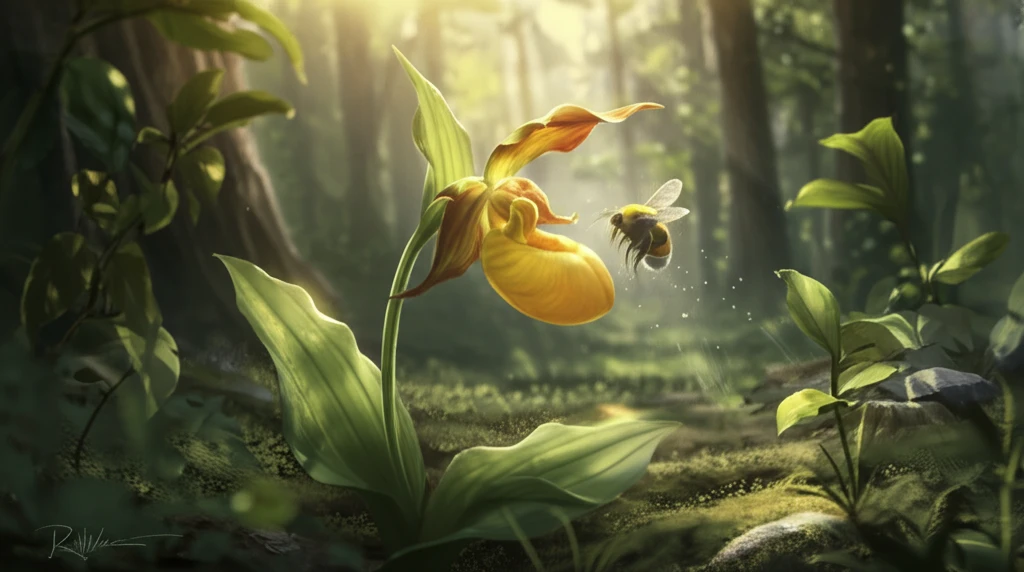
Orchid Size Matters: How Bumblebees Influence Plant Evolution
"Discover the surprising role of bee size in the pollination of Cypripedium orchids and what it means for plant diversity."
In the world of plant evolutionary ecology, it's often assumed that pollination syndromes—specific combinations of flowering periods, floral shapes, colors, scents, and rewards—are highly specialized. These traits are thought to reflect a tight interdependence between plant species and the sensory preferences of their pollinators. However, nature rarely fits neatly into predefined categories. Plant species with wide distributions can exhibit considerable variation, often divided into distinct variants or subspecies. This raises an intriguing question: if floral traits vary significantly within a species, does this indicate differences in pollination syndromes?
Consider Cypripedium parviflorum, a widely distributed orchid in North America, commonly known as the yellow lady's slipper. This species presents an ideal case study for exploring the nuances of pollination ecology. Subdivided into three varieties—makasin, parviflorum, and pubescens—C. parviflorum displays notable differences in floral characteristics. While var. pubescens boasts larger flowers, size variations within these orchid types have been observed to vary due to age, sunlight and soil types. Despite their close proximity in shared habitats, the question lingers: do these varieties remain reproductively isolated, perhaps relying on different insect species for pollination based on their respective flowering seasons and floral dimensions?
A recent study delved into the pollination ecology of two sympatric varieties of Cypripedium parviflorum in Missouri, United States, to unravel the impact of floral dimensions on pollinator diversity. By comparing insect visitors to sympatric populations of C. parviflorum vars. parviflorum and pubescens, the research sought to determine whether floral traits dictate pollinator specialization or if these orchids attract a broader range of pollinators regardless of size. The findings shed light on the intricate relationships between orchids and their pollinators, challenging conventional assumptions about pollination syndromes and offering insights into the factors driving plant evolution.
Bee Size and Orchid Pollination: A Delicate Balance

The study meticulously observed and collected insects entering the labella (the pouch-like petal) of Cypripedium parviflorum varieties, comparing insect communities between sympatric and allopatric populations in Missouri. Over four seasons, a total of 235 insects were collected and analyzed, revealing a fascinating pattern: the most effective pollen carriers were small- to medium-sized bees, averaging 6.75 mm in length, 2.28 mm in width, and 1.82 mm in depth. These native bees, particularly polylectic females from the family Halictidae (sweat bees), emerged as the dominant pollen mass carriers for both orchid varieties.
- A diverse range of bees pollinate C. parviflorum, reflecting local distributions and seasonal changes.
- There is overlap in bee species visiting both varieties and in their flowering periods.
- Floral morphometrics suggest limited intergradation between the two sympatric varieties.
- Intraspecific isolation at one site appears influenced by differing phenology, floral presentation, and regional distribution.
Implications for Conservation and Understanding Plant Evolution
This research highlights the importance of considering multiple factors—including flowering time, floral presentation, regional bee distribution, and bee size—when studying plant-pollinator interactions. The subtle interplay of these factors can drive intraspecific isolation and potentially lead to the evolution of new plant species. Further research, including studies on pollinia transport distances and the presence of post-pollination barriers, is needed to fully understand the reproductive dynamics of Cypripedium parviflorum and other orchids. By unraveling the complexities of orchid pollination, scientists can gain valuable insights into plant evolution and develop more effective conservation strategies for these captivating and ecologically significant plants.
